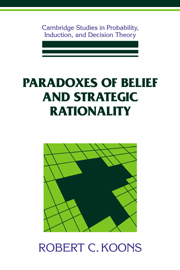Appendix A - Applying probability to mathematical sentences
Published online by Cambridge University Press: 06 January 2010
Summary
In order to apply subjective probability measures to necessarily true or false mathematical statements, I suggest that we use Hintikka's distributive normal forms and the related idea of the depth of a formula. We are to imagine the implications of intuitive mathematics as unfolding in an infinite series of stages. At stage n, all sentences of depth n or less and of length f(n) or less (where f is some monotonically increasing one-place function) are checked for self-evidence. There are only finitely many such sentences, and we have seen that there must exist an effective procedure for deciding whether a given sentence is self-evident. Sentences that are found to be self-evident at stage n are called “n-self-evident sentences.” All of the n-self-evident sentences are then transformed into Hintikka's distributive normal form at depth n. (There is an effective procedure for this transformation.) A sentence in distributive normal form at depth d is expressed as a finite disjunction of constituents of depth d.
There are only a finite number of constituents of depth n. They are mutually exclusive and jointly exhaustive of logical possibility. Those constituents of depth n that are not trivially inconsistent and that occur in the distributive normal form of all of the n-self-evident sentences are to be called the “n-possible constituents.” The n-possible constituents describe states of the mathematical world that cannot be shown by means of any effective procedure to be mathematically impossible, given the state of development of intuitive mathematics at the nth stage.
- Type
- Chapter
- Information
- Paradoxes of Belief and Strategic Rationality , pp. 153 - 154Publisher: Cambridge University PressPrint publication year: 1992

